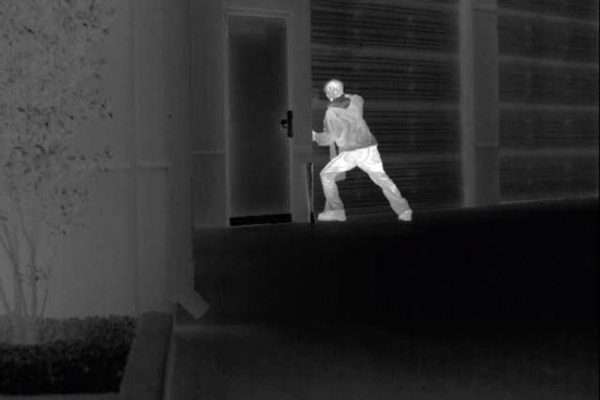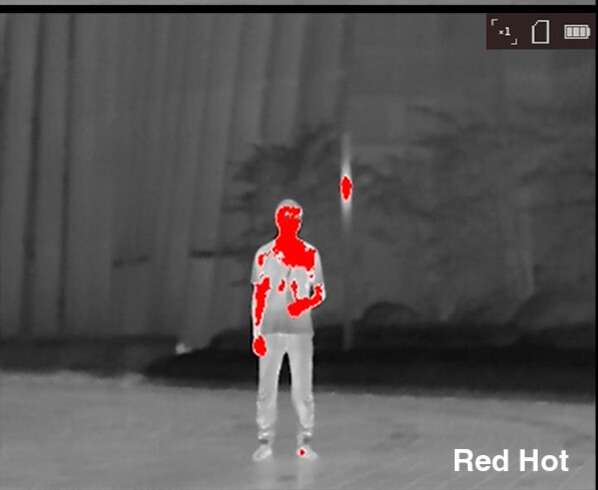Different Thermal Color Palettes In Thermal Infrared Cameras
Thermal imaging color palettes, ranging from high-contrast black and white to multi-colored gradients, are crucial for enhancing the interpretability of temperature data in diverse applications.

Upload Your Image Here To Simulate The Different Thermal Palettes We Offer At UAV1.com
Upload and simulate every thermal palette. Works best on black and white images. When dragging the slider make sure to click load image on each palette for the thermal palette to be correctly simulated!
Thermal imaging technology has revolutionized the way we perceive the invisible world of heat around us. A critical component of this technology is the use of color palettes, which translate the temperature data captured by thermal cameras into visual forms that are easy to interpret and analyze. These palettes apply different colors to represent various temperature ranges, allowing users to quickly identify hot and cold spots in a scene. From security surveillance to predictive maintenance in industrial settings, the choice of color palette can greatly enhance the utility and readability of thermal images. Each palette offers a unique perspective; for instance, some provide high-contrast visuals for quick detection of subjects, while others offer a gradient of colors for detailed analysis of temperature differences. Understanding the nuances and applications of different thermal palettes is key to maximizing the effectiveness of thermal imaging in any given context.
Black Hot Thermal Color Palette Overview
The "Black Hot" color palette is a monochromatic thermal imaging setting where the hottest points in the camera's field of view are represented in black or darker shades, while cooler areas appear in white or lighter shades. This palette is designed to simulate the way the human eye perceives shade and light in the natural visual spectrum, thereby making it intuitively understandable.
In practical terms, the Black Hot palette is particularly effective in scenarios where the subject of interest is warmer than the surrounding environment. For instance, in a nighttime wildlife survey, warm-blooded animals would appear as dark shapes against the lighter background, standing out distinctly for easy identification. Similarly, in a security context, human intruders would be instantly noticeable against a cooler landscape or environment.

One of the key advantages of Black Hot is its simplicity, which reduces the cognitive load on the user, making it less likely to misinterpret the image. Moreover, the high-contrast imagery facilitates better detail recognition at longer ranges, which can be crucial in surveillance or search-and-rescue operations.
Moreover, the Black Hot palette helps reduce screen glare in low-light conditions, which can be less straining on the eyes for users who need to monitor screens over long periods, such as in surveillance or continuous inspection tasks. This can help mitigate fatigue and maintain high levels of concentration.
White Hot Thermal Color Palette Overview
The "White Hot" thermal color palette is essentially the inverse of the Black Hot palette. In this mode, the warmer areas in the camera's field of view are displayed in white or lighter shades, whereas cooler areas are shown in black or darker shades. This color scheme is one of the most widely used in thermal imaging because it aligns with a naturalistic view — similar to how we perceive light and shadows with our eyes in a typical grayscale photograph.
White Hot is particularly beneficial for emphasizing hot objects against cooler backgrounds, making it an excellent choice for applications such as law enforcement and first responders, where identifying people or animals is crucial. In search and rescue operations, for instance, human figures show up clearly against the cooler landscape, allowing for quick detection.

This palette is advantageous in a variety of conditions, offering clear contrast that is helpful for identifying subjects quickly and accurately. It is especially useful in urban environments where the ambient temperature is often variable and complex, and where heat sources such as vehicles and machinery need to be distinguished from human subjects.
The clarity and simplicity of the White Hot palette make it a good choice for interpretation of thermal data by users of all skill levels, reducing the likelihood of errors in identification and allowing for rapid decision-making. It's also useful for long-range detection tasks, as the high-contrast white shapes of targets can be seen more clearly against darker, cooler backgrounds.
In essence, the White Hot palette serves as a universal tool in thermal imaging, providing a straightforward, high-contrast view that enhances the visibility of heat-emitting objects in a variety of environments and operational contexts.
Sepia Thermal Color Palette Overview
The "Sepia" thermal imaging color palette applies a warm, brownish tone to the thermal image, which is reminiscent of the sepia-toned photographs from the late 19th and early 20th centuries. This palette is particularly favored for its ability to reduce eye strain, as the monochromatic sepia tones are softer on the eyes compared to the high-contrast black and white palettes.
In the Sepia palette, warmer objects still appear lighter, much like in the White Hot setting, but with a range of brown shades rather than greyscale. This can help operators maintain visual acuity during prolonged observation periods, such as in long surveillance sessions or extended wildlife monitoring, as the warmer, more uniform color scheme is less taxing on vision.

Additionally, the sepia palette can enhance detail recognition in certain contexts, as it provides a subtle gradation of temperatures, potentially making it easier to discern fine differences in heat signatures. This can be particularly useful in environments where the thermal contrast between objects and their background is less pronounced, allowing for a more nuanced interpretation of the scene.
The calming effect of the sepia tones also tends to be easier on night vision, which is an important consideration for users who need to transition between looking at a thermal display and observing their surroundings in low-light conditions.
Overall, the Sepia thermal imaging color palette is a practical choice for scenarios requiring extensive periods of observation and where user comfort is a priority, without sacrificing the detail that thermal imaging provides.
Iron Thermal Color Palette Overview
The "Iron" thermal imaging color palette is characterized by its distinctive use of vibrant colors to represent different temperatures, creating a gradient that often spans from cooler blues and purples to warmer oranges and reds. This palette is sometimes referred to as "Ironbow" and is inspired by the coloration of heated metal, which transitions from black to red to yellow to white as it increases in temperature.
This color scheme is particularly useful for applications that require the identification of subtle differences in temperature because it offers a gradient scale where incremental changes can be easily discerned. For instance, in industrial settings, the Iron palette helps in pinpointing hot spots in machinery or electrical circuits, as even minor variances in temperature are highlighted by gradual color shifts.

The Iron palette's range of colors can significantly enhance the detail visible in a thermal image. For instance, in medical thermography, the Iron palette can help health professionals visualize and analyze blood flow and inflammation by highlighting the slight temperature variations indicative of these conditions.
Moreover, because of its ability to illustrate thermal gradients, the Iron palette is also popular in educational and research contexts, where detailed thermal analysis is necessary. The rich colorization can make thermal processes more visually intuitive, aiding in the interpretation and presentation of thermal data.
In summary, the Iron palette is a versatile and detailed-oriented choice that is valuable across various fields, helping users to detect and analyze fine thermal differences with greater clarity and definition.
Rainbow Thermal Color Palette Overview
The "Rainbow" color palette in thermal imaging is one of the most visually vibrant and informative palettes available. It employs a broad spectrum of colors to represent different temperature ranges within a scene, often resembling a rainbow, hence the name. This palette can map a wide range of temperatures to a diverse color set, with cooler areas typically appearing in purples and blues, moderate temperatures in greens and yellows, and the warmest areas in reds and oranges.
This rich colorization makes the Rainbow palette particularly useful for detailed analysis and diagnosis in thermal imaging. Each color transition corresponds to a specific temperature change, allowing for precise temperature differentiation and the ability to detect subtle variances and patterns that might be overlooked with more monochromatic palettes. In complex thermal scenes, such as those involving fluid dynamics or heat dissipation, the Rainbow palette can help identify the nuanced distribution of heat.

The Rainbow palette is frequently used in scientific research, electrical inspections, and building diagnostics where identifying a wide range of temperature differences is crucial. For example, it can help visualize energy loss in buildings, detect overheating components in electrical installations, or illustrate thermal phenomena in educational settings.
Moreover, the Rainbow palette's detailed color range not only enhances the utility of thermal imaging for expert analysis but also helps in clearly communicating thermal information to a broader audience, making it an excellent tool for educational purposes and reporting.
In essence, the Rainbow palette provides a highly detailed thermal image that is not only scientifically useful but also visually striking, facilitating both the identification and the communication of thermal information.
Red-Hot Thermal Color Palette Overview
The "Red Hot" color palette in thermal imaging is designed to highlight the warmest parts of the image with a red or similar warm color, making it exceptionally useful for identifying high-heat sources in a field of view. In this palette, the hottest zones stand out in vivid red tones against a less colorful background, which can be either monochromatic or involve other subdued colors for cooler areas.
This palette is particularly beneficial when the primary objective is to locate heat sources quickly. For instance, in firefighting, it can help identify hotspots within a smoke-filled environment. In industrial settings, the Red Hot palette allows for the rapid detection of machinery or components that are overheating, potentially preventing equipment failure or fire hazards.

Red Hot's stark contrast between the hottest areas and the rest of the image simplifies the task of pinpointing critical temperatures without the distraction of intermediate heat ranges. This makes it a preferred choice for surveillance tasks as well, where human or vehicle targets need to be quickly distinguished from the ambient temperature.
In essence, the Red Hot palette serves as a focused tool for immediate thermal detection, emphasizing critical temperatures that may indicate emergency situations or require urgent attention.
